About the Author: Cristian S. Aluas is professional artist and author of It’s a Living: Surviving as a Freelancer in the 21st Century, and has online courses on cartooning techniques at MasterpieceArtSchool.com
Although the term “graphic novel” is only 40-some years old, this form of storytelling has exploded in popularity. Chances are you were assigned graphic novels to read in high school, and chances are you’ve thought about writing one yourself. But, learning how to write a graphic novel isn’t easy, as it combines the essentials of both writing and graphic design.
What is a graphic novel, and how do you write one? What is the difference between a graphic novel vs comic series? This article sets the foundations for the form, guiding you through different graphic novel techniques to create visual stories that move, entertain, and delight the audience.
Writing a graphic novel, a comic, or a manga is not easy. Many first-time comic book creators need help but they don’t know where to begin. The five crucial tips in this article are the perfect place to start. But first, let’s understand the form a little bit better. What is a graphic novel?
What is a graphic novel?
A graphic novel is a complete story told through words and pictures combined. It’s evolved over the years, from hieroglyphs, to cartoons, to comic strips, and finally to what we see today.
A graphic novel is a complete story told through words and pictures combined.
Whereas a novel leaves the pictures to our imagination, in a graphic novel, the artist depicts the narrative in a funny or serious way, depending on style and genre. The style of art is what makes fans linger on the page, and the writing is what moves the story along.
The style of art is what makes fans linger on the page, and the writing is what moves the story along.
Graphic novel vs. comic vs. manga
American cartoonist Will Eisner coined the term “graphic novel” when he wrote and drew A Contract with God in 1978. He had been a comic strip artist for many years, drawing The Spirit in syndicated newspapers, before he came up with his expressive visual language. Frank Miller with Sin City followed suit in the 1990s. With serialized collections of The Dark Knight Returns, Watchmen, and Ghost World, the foundation was set for comic strips to be considered more mature. Collectors became readers. New elements of realism permeated comics, along with their new presentation, making graphic novels in America a popular new format—although, in Europe, the collected graphic novel, in the form of bande dessinée, was already the main form of consumption.
Comics are serialized American strips and manga is what the Japanese call comics. Most manga series in Japan are led by one creator with a team of assistants, while in America companies like Marvel and DC own the intellectual property of the characters and writers and artists alternate as contributors over the course of years. In Japan, the artist is often also the writer and the art style remains the same for the span of the series.
Comics and manga tell stories in installments; graphic novels tell complete stories.
Similarly, in Europe, artists like Hergé, Moebius, or Enki Bilal kept their aesthetics the same throughout their careers. Essentially, comics and manga fall in the same category as serialized strips each for specific demographics, while graphic novels can be collections of those strips into stand-alone stories or new sequential stories done specifically for a paperback or hardcover format.
Graphic novel techniques
Artists rely on many graphic novel techniques to tell visually compelling stories. Here are just a few common ones to get a writer started:
Narration Over Setting: Describing the mood of the locale or characters, while showing the location or personalities plainly.
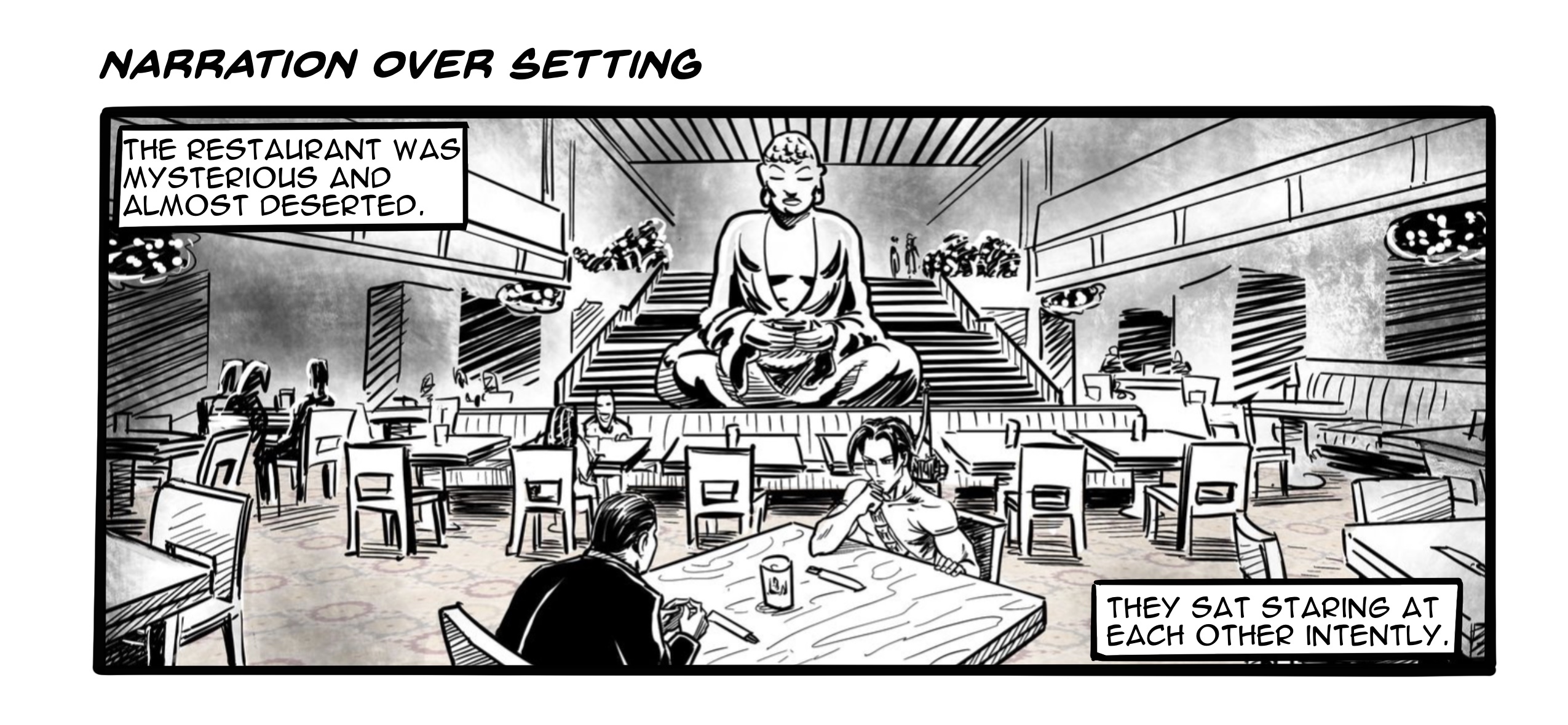
Same/Same: The writing describes the actions in the panels and the thoughts of characters.
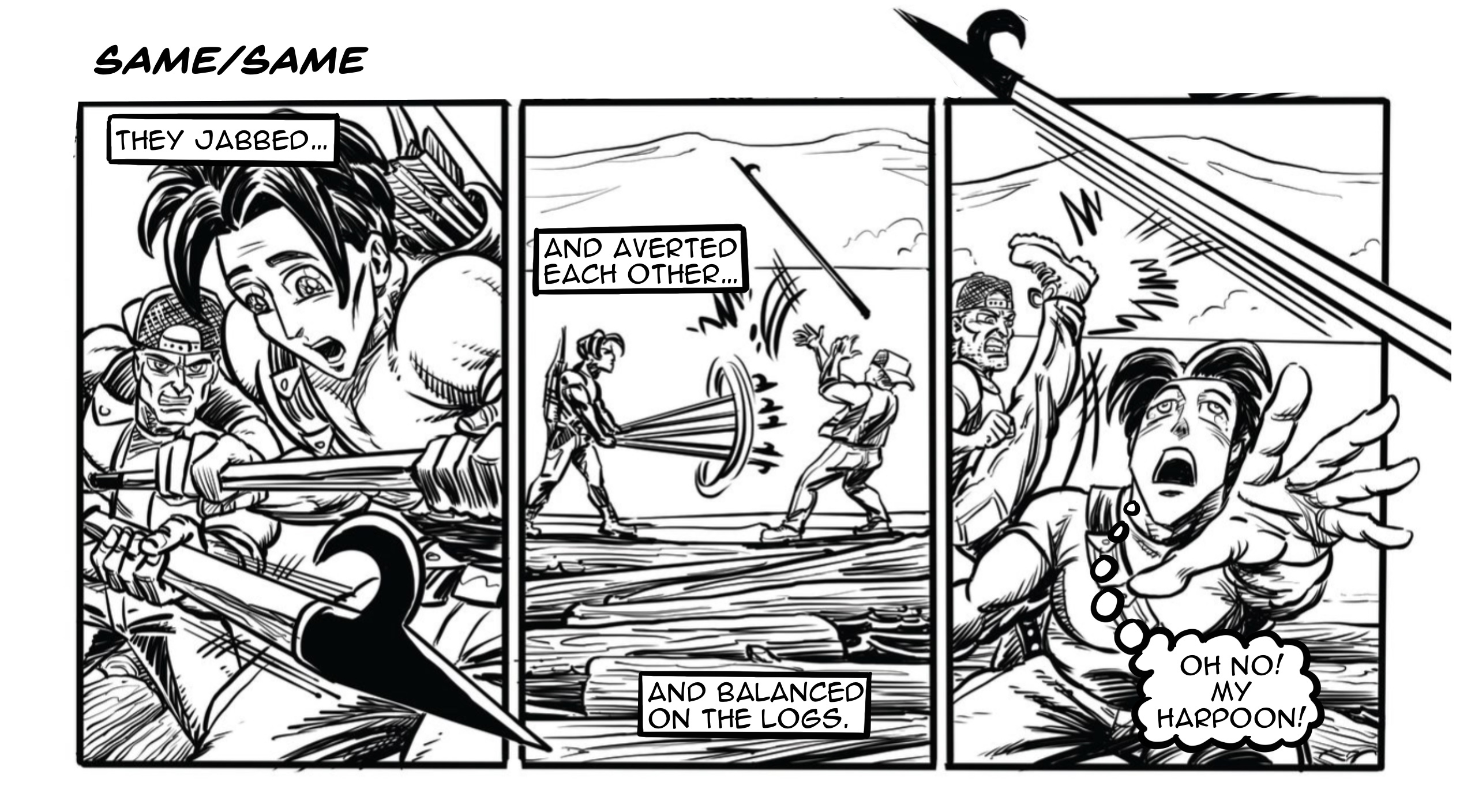
Alternate Descriptions: The narrative can act like a voiceover, with the visuals displaying something else entirely.
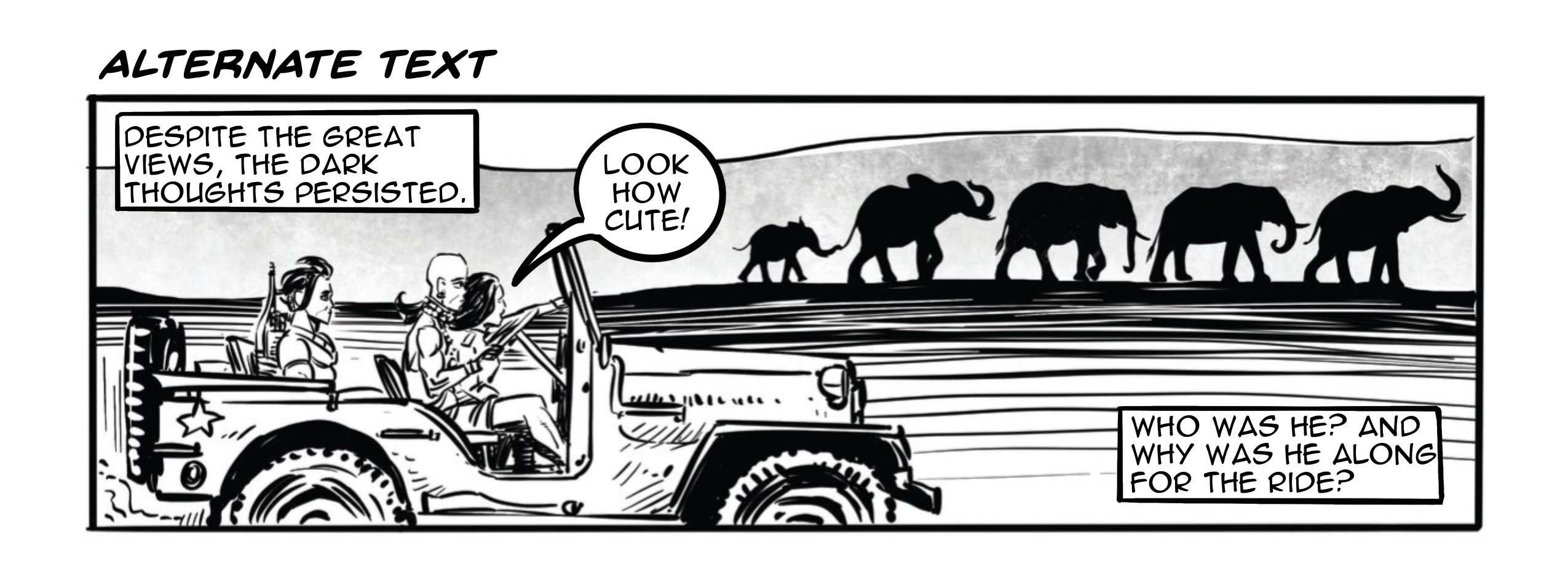
Transitional Text: Like in film, the conversation or narration from a previous panel carries over into the next, with the visuals often mirroring each other.
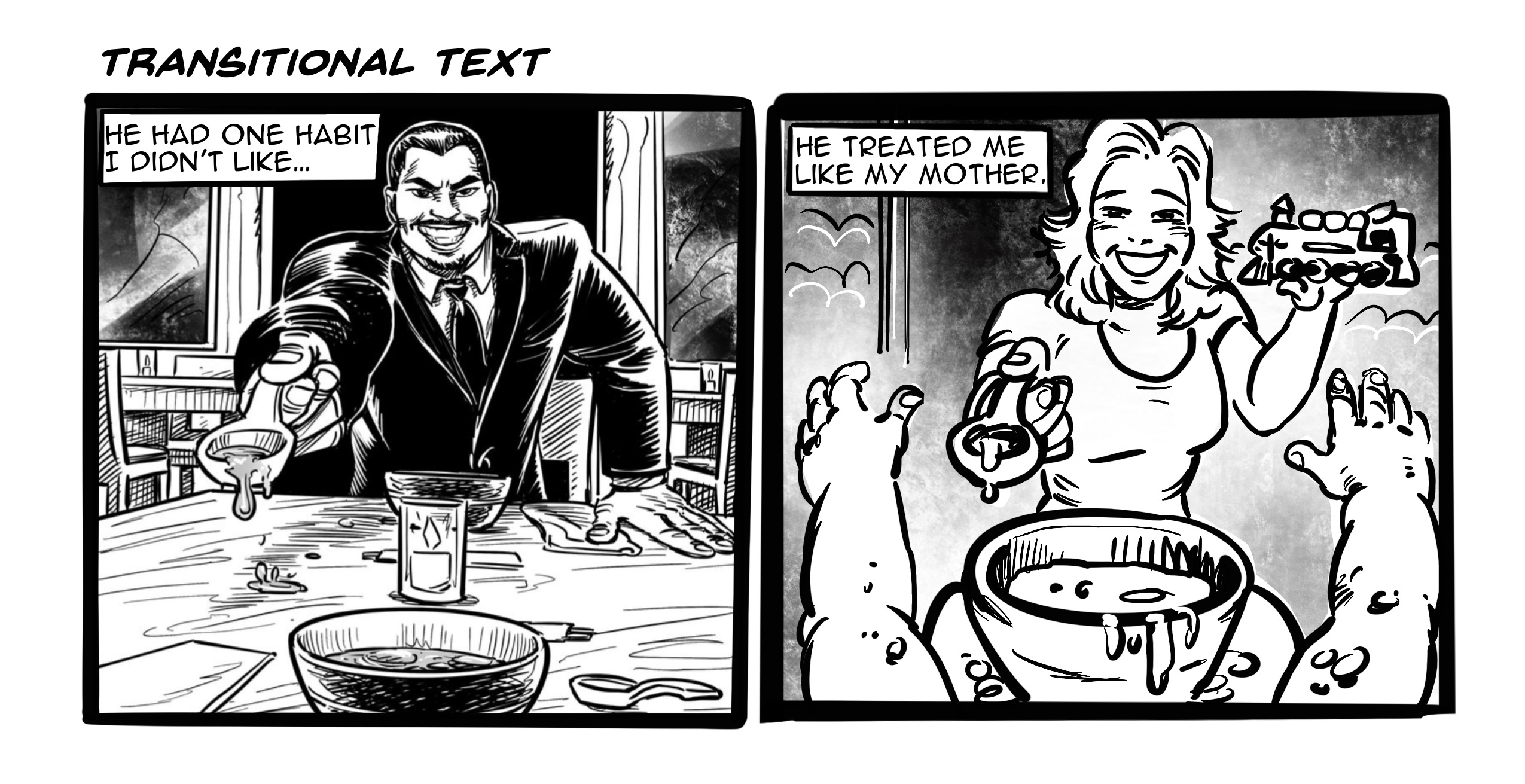
Pay attention to each of these techniques in the graphic novel examples we share later in this article.
How to write a graphic novel in 5 key points
Before you set pen to paper (or cursor to Photoshop), make sure you understand these 5 key points on how to make a graphic novel.
1. Genres and demographics
Before scripting a graphic novel, a writer must consider the genres they’re writing in and the age group they’re writing for. There are many to choose from, such as memoir, superhero, political (comedy, farce, or commentary), biography, crime, romance, and many more! Combining genres is a smart choice, like horror/romance or adventure/comedy or steampunk/superhero, etc.
Manga is typically serialized and can be very specific about subject matter (like baseball or academia). The demographics are also younger and very specialized too, influenced by the manga’s themes.
According to the demographics of webtoons.com, most readers of manga read romance and are young girls between the ages of 13-21.
In American comics, there’s a boom in content for adolescent boys and girls, in the vein of Raina Telgemeier’s Smile or the Captain Underpants series.
There’s still a market for boys however, overseas and in America. Action, adventure, sports, and mature themes interest young adult boys, as readers. The nostalgia buffs from the 90s comics boom are being overwritten with new trends in non-superhero comics. The Marvel and DC movies are most popular with this latter demographic.
As a result of the popularity of the Marvel and DC films and manga imports starting in the late 1980s, the style of American sequential storytelling has changed. Comics and graphic novels read more like storyboards now. They are sparsely-written, compared to the 60s Stan Lee comics or the Chris Claremont X-Men. In the 2020s, graphic novels are written with manga and films at their backs. This writing style is also a result of writers having the space to tell a story in whatever amount of pages it takes, rather than being limited to a newspaper page, an eight page short, or a standard 22 page Marvel/DC issue.
2. Structure & Storytelling
Once a writer chooses a genre to write in, they have to outline the story like any other book. Clear structure is even more important in comics and manga, especially if the stories are being serialized. Famous comics writer Alan Moore (of Watchmen and V for Vendetta fame) said that in serialized comics, what people see is your “first draft” so you have to make it count. That’s why his first 32 page issue of Watchmen was sent to the artist Dave Gibbons as a 90 page densely-written script.
Screenwriting (and some playwriting) principles can be useful for learning how to write a graphic novel script—more so than novel writing. Namely, it’s recommended for every story or chapter to have a purpose, characters to have developmental arcs, and stories to follow the general three act structure of introduction, climax, and denouement.
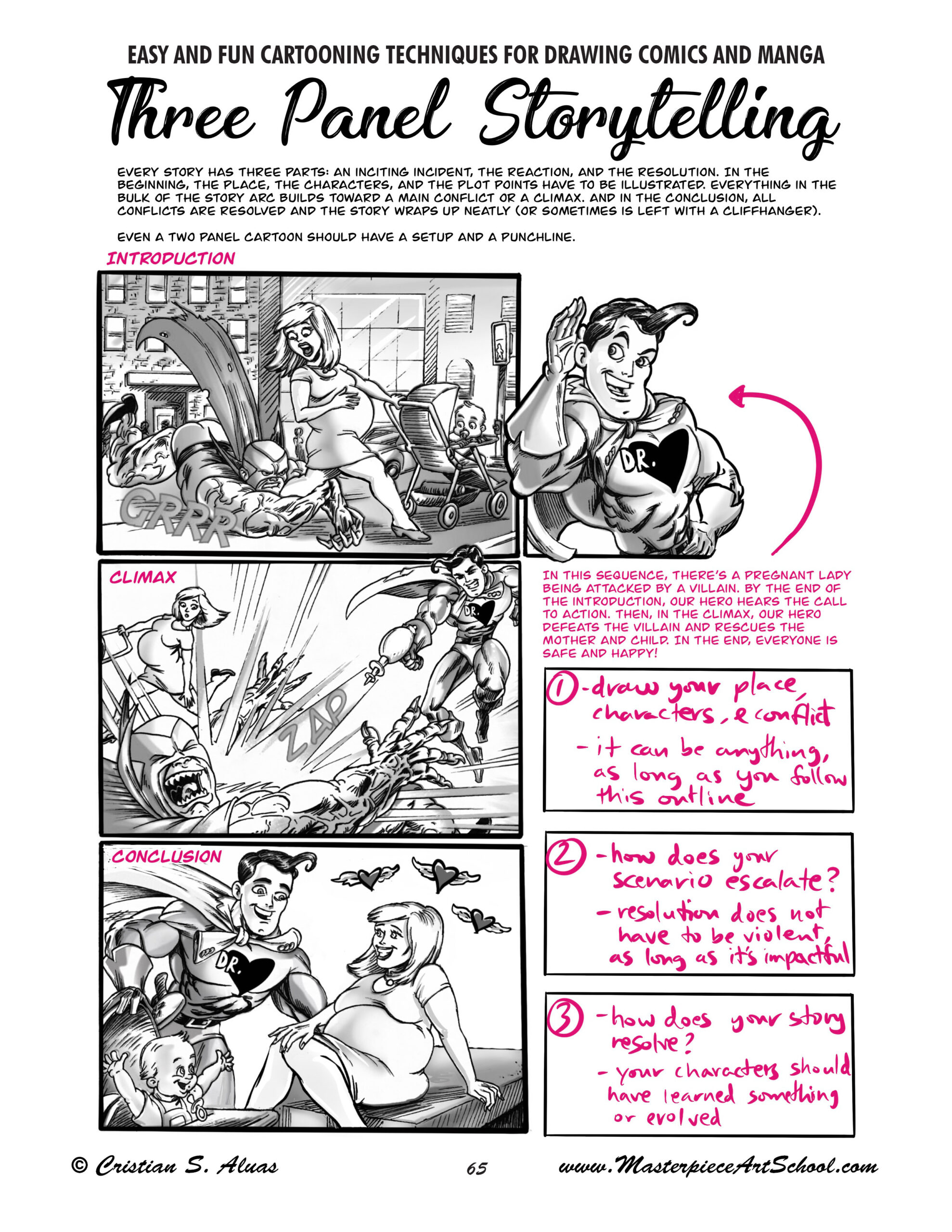
3. Format
Formatting your graphic novel story is similar to formatting a screenplay. A writer has to break down the story onto the scripted page, not only scene by scene, but also panel by panel. These detailed directions are for the artist to understand what to depict.
The Marvel Way of storytelling is: when the writer gives a one page outline, the artist goes off and paces the paneled story how they see fit, then the writer comes back at the end to embellish the dialogue. This loose method would only be recommended if the writer was collaborating with an artist, or if the artist has more experience pacing the story than the writer. If the writer is the more experienced of the team, they should write the tightest script they can. Clarity is best in all forms of communication, including graphic novels.
A good graphic novel writer acts like a film director who also writes the script and the artist functions as the actors and the sets.
The best writers think in pictures. With graphic novels, both the text and illustrations are meant to work perfectly in tandem—both in service to the story.
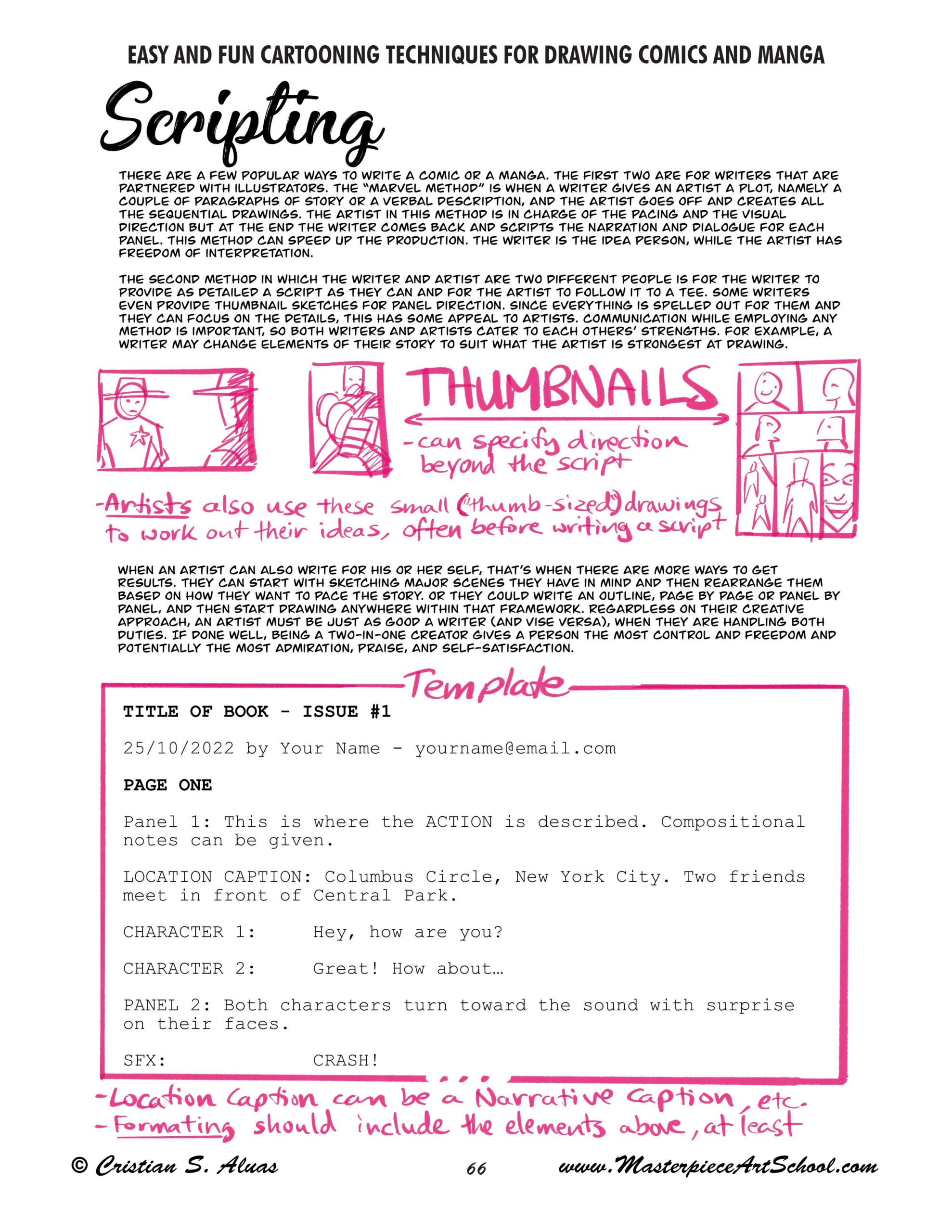
4. Page and panel layout considerations
When writing graphic novels, you’re writing for the visual language. The visual symbols chosen in each story hold archetypal meanings to the readers, such as snakes (Biblical reference) or characters’ powers in relation to mythological gods (like Thor or Zeus).
Graphic novels can be influenced by paintings or by films but they are their own artwork. A comic that tries too hard to be a film is a storyboard. There are many art techniques that are only available in comics and deserve to be explored.
If you’re new to writing for comics, it’s recommended that you acquaint yourself with books like Understanding Comics by Scott McCloud and Comics & Sequential Storytelling by Will Eisner, to name a couple very influential authorities on the subject. Their books help you consider the pacing of your comic or manga. A succession of small panels, for example, can slow down time (like the slow drip of a faucet) or can illustrate a series of actions (like a fight sequence).
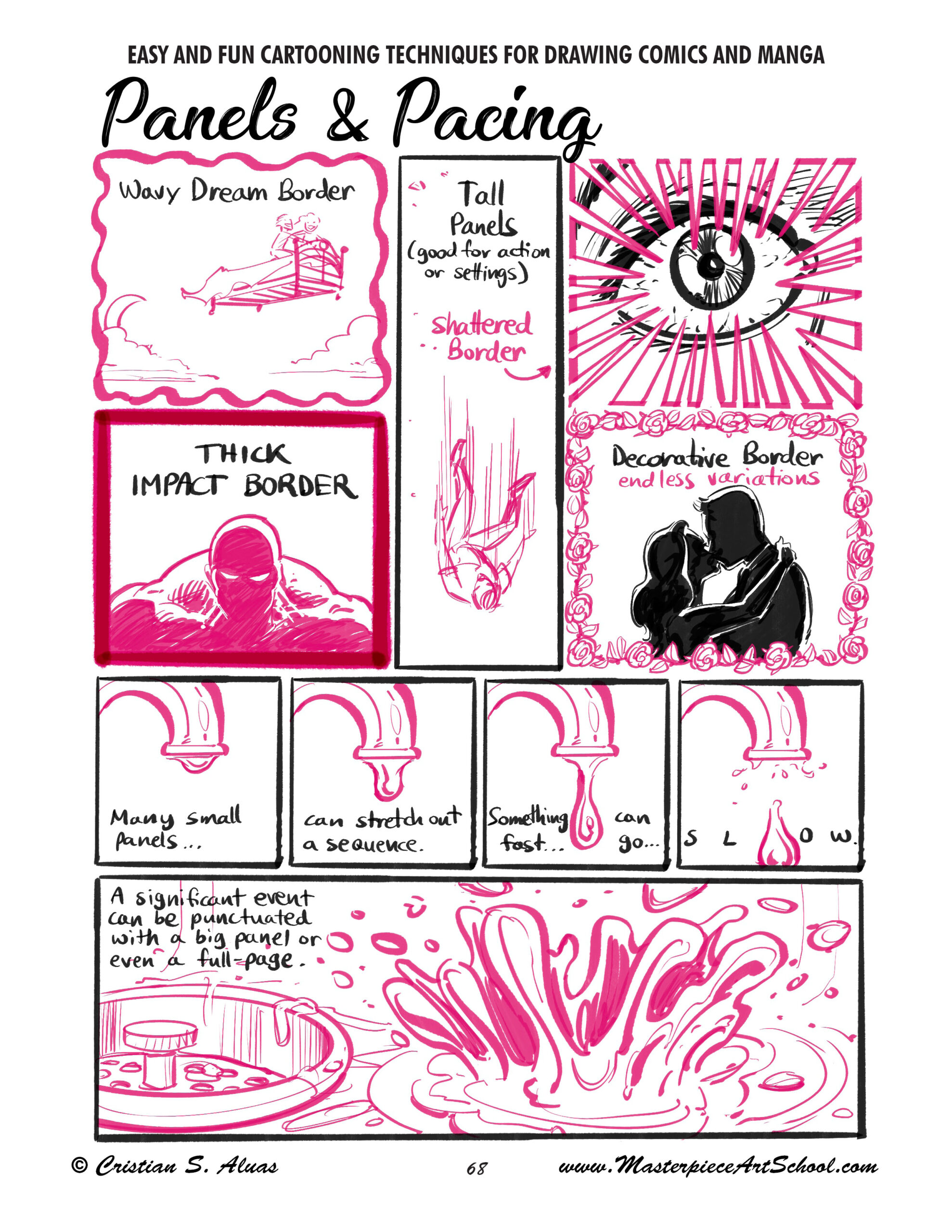
Book lengths are 22 pages for American serialized comics. Collections of storylines typically compile four or more issues into trade paperbacks. Stand-alone graphic novels are suggested to start at 65 pages, going into the hundreds of pages. And manga webtoon episodes typically need to deliver an average of 30-40 panels per week (or bi-weekly). Colour or black and white art is up to the discretion of the writer/artist. To colour or not to colour is also a choice made based on the mood and literary themes of the story.
Much like film, often a comics writer has to describe the reader’s point of view, as if it was a camera view. When doing this, comic writers must be deliberate and only choose one viewpoint. Knowledge of compositional devices are useful, such as foreground, middle ground, and background. If you’re working with an experienced artist, you can leave most of the composition to them. You have to have a good eye for understanding what good art is however—good art that conveys a clear story. Sometimes a writer working with a collaborator has to draw thumbnails for the artist, to clarify ideas.
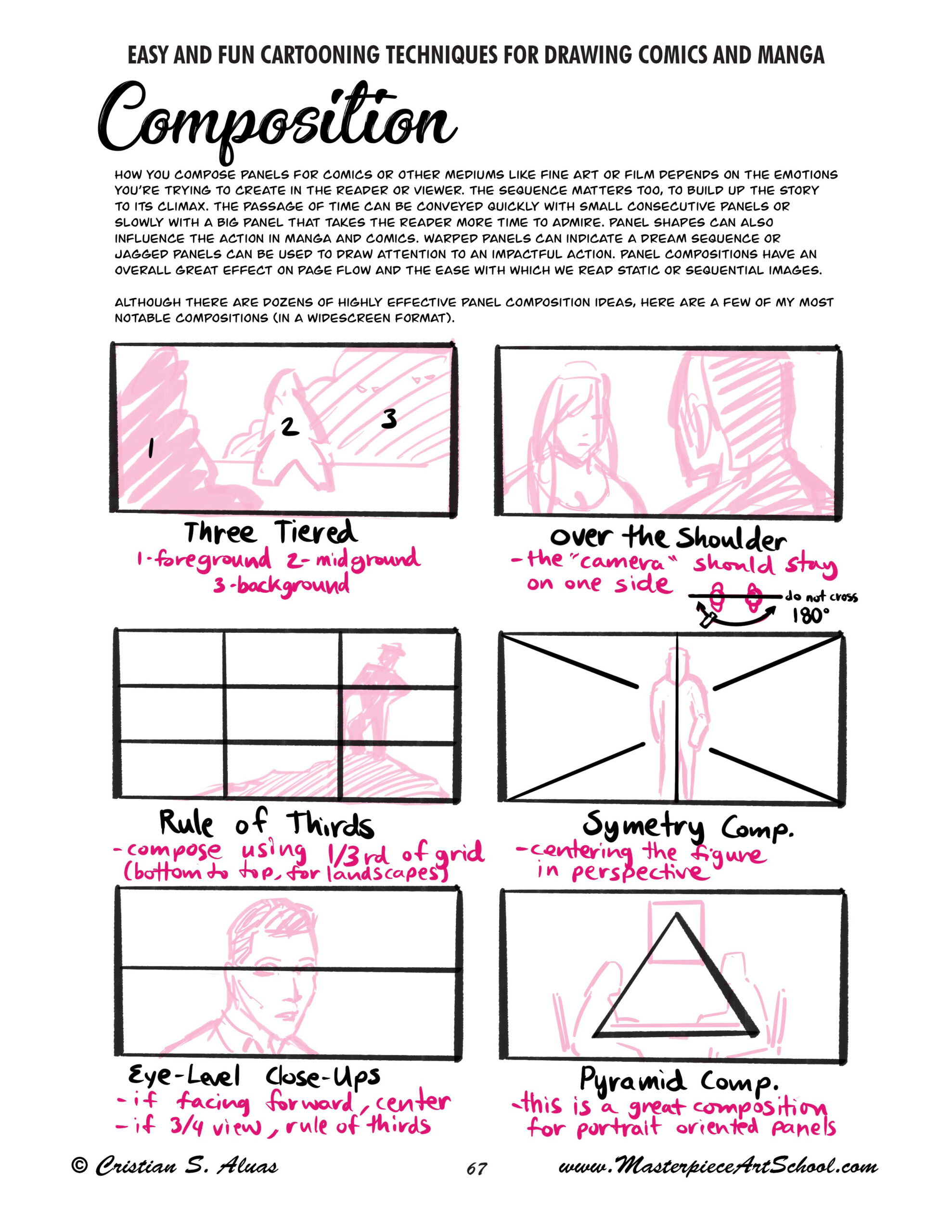
5. Drawing
When a writer has a mastery of drawing as well, they become complete cartoonists and their vision is most true.
At the least, a writer of comics should have basic drawing skills, along with an educated storytelling vocabulary. Most writers write comics because they enjoy reading them in the first place. If your drawing skills are non-existent or not up to par, taking art lessons are encouraged. Like a composer, a graphic novel writer is the orchestrator of the full effect on the reader. Therefore, it’s good to know how to play every visual instrument, or at least understand how each visual conveyance will further the story along toward your creative purpose.
The style you choose initiates your audience, as Scott McCloud illustrates in Understanding Comics.
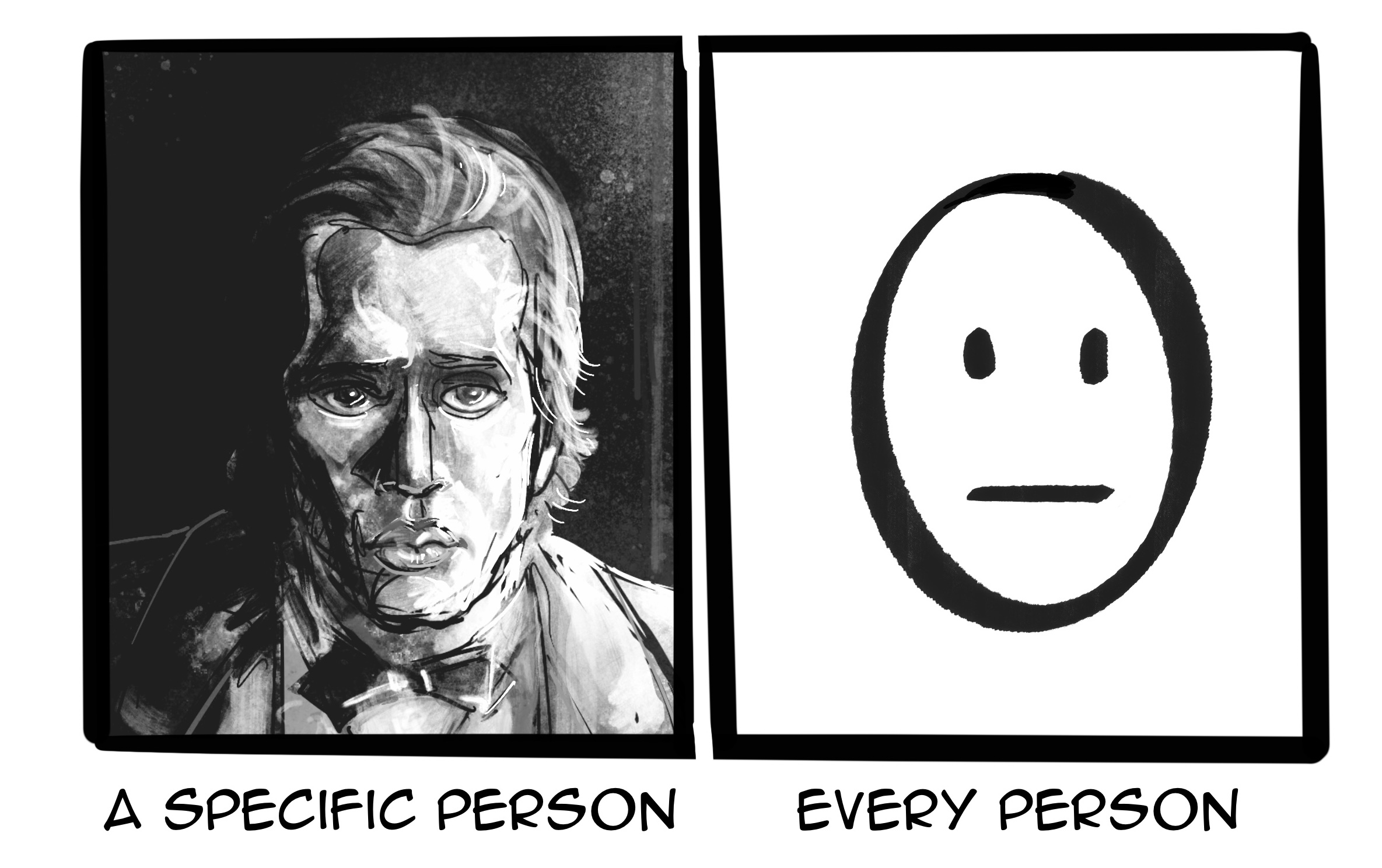
BONUS:
In American graphic novel collaborations, graphic novels have a separate artist that does only the lettering. Comic book letterers play an important part in communicating the story. Although it’s not required to specify in your script what type of word bubble is needed in each panel, it’s important to know the visual language that’s available to you as a graphic novel creator. Here are some fun lettering tips to consider, as you write your graphic novel.
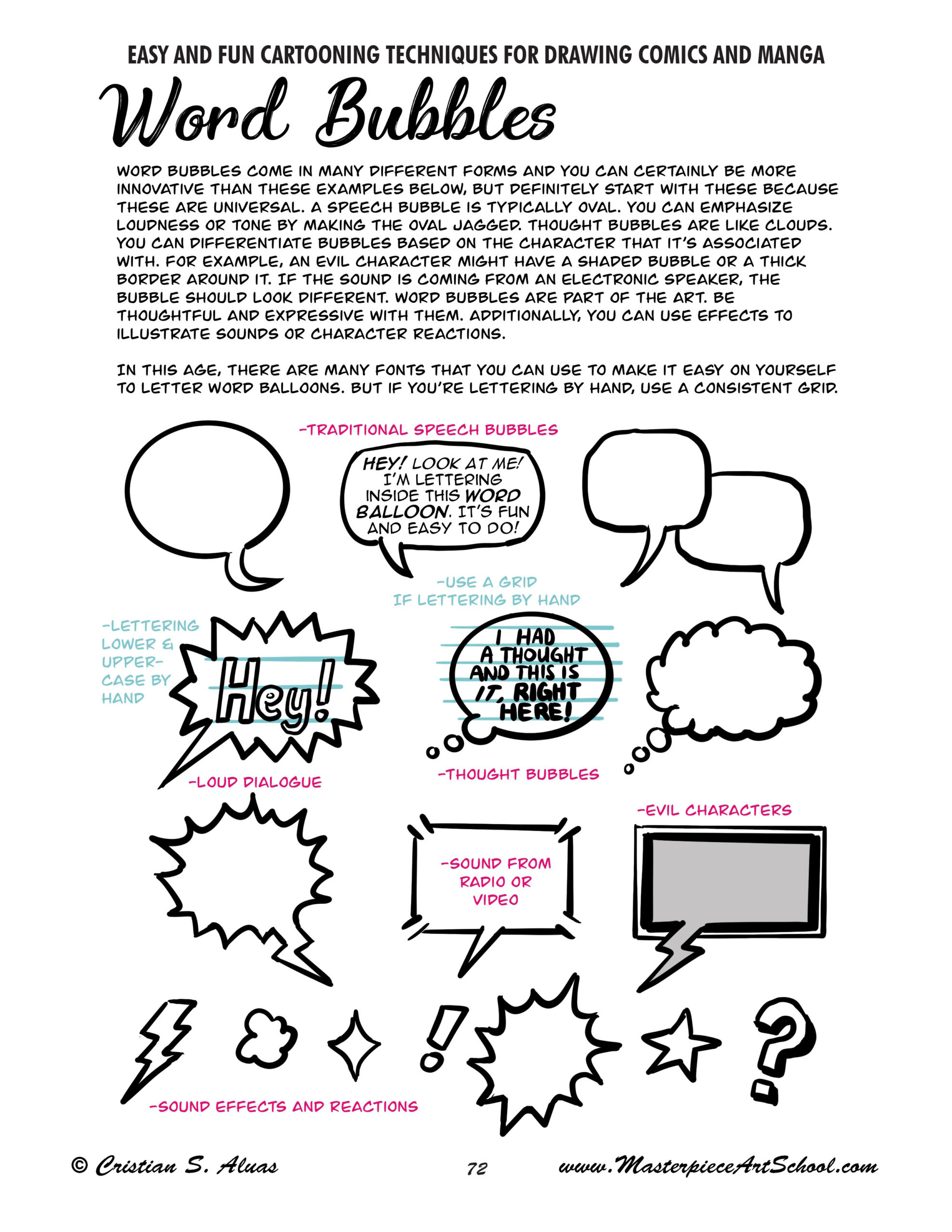
Graphic novel examples
The following graphic novel examples have remained in the zeitgeist since they were written; many graphic novelists have found inspiration from these canonical works.
- Batman: The Dark Knight Returns
- Watchmen
- Contract with God
- Ghost World
- Smile
- Maus
There are several subscription-based and free websites where you can read graphic novels for free. Comixology.com, which is owned by Amazon, has a huge collection of comics (some free). Webtoons.com has a large selection of manga which is all free. And you can read public domain comics for free at Comicbookplus.com. Tapas and Webnovel are other sites to explore. And every year on May 5th, mainstream publishers give away comics on “Free Comic Book Day.”
Crafting the Graphic Novel
Graphic novels are a part of our popular culture. That’s why they get compared to film and art. But they are not quite film nor art. They stand more strongly as their own art form. As an author, learning how to write a graphic novel is a choice based on your love of the medium and what it has to offer that’s different from other media.
There are authors, there are writers, there are writer/artists. The combination makes cartoonists. If you can do both, that’s what you are. If you do one or the other, you simply love the medium and you love to collaborate.
There are many factors to a well-written graphic novel. Having the right illustrator with a complementary style makes a big difference.
The beauty of graphic novels, as opposed to serialized comics or manga, is that there isn’t the time pressure of a monthly deadline. A writer can take their time, like an author, and craft (through numerous drafts) the best graphic novel they can possibly make. After all, the term “graphic novel” came to popularity by comic book and manga creators that desired this art form be lifted to the prestige of literature.


So much detail, so informative. I’m thankful for coming across this read. You can tell Mr. Cristian Alaus has years of experience in the graphic novel genre, and he was so generous in sharing his expertise in illustrations. Thank you
Amazing amount of detailed information step by step!
Complete and complex yet understandable
The article looks like a great starting point. Thanks!
Nice job. As a cartoonist, I can can vouch for the articles accuracy.
Thanks guys for the positive feedback on the article! I’m still very proud of it. It was great to get my ideas together on the subject of writing for comics and manga and I’m happy it’s helping you! If any questions came up in your writing process that I didn’t cover here, just let me know. I’m around. 🙂
Great article. I can attest to it’s accuracy being a cartoonist myself. I look forward to seeing your work.
Thank you, Dale! I’m happy you appreciated the article! I’m writing and drawing a couple of comics for indie clients. So we’ll see when those come out. 🙂 And writing my first novel. Hoping to release that next year. Good luck with your writing too! Please keep in touch -LinkedIn or IG!
Thank you for all the info!!! I was hoping to find some graphic novel page sizes or template suggestions for my first foray into this new medium(for me).
Hi Jesse, you’re welcome! The standard comic book size is 6-5/8 inches wide by 10-1/4 inches high. You can make your own template in Photoshop or Procreate, as I do. Search google and click on Images. Ka-Blam has a good template that I use as a low opacity layer so I can see the margins. This if for print. For webtoons, it’s a scrolling page and different size. I highly recommend getting and reading the full book if you’re a beginner. It’s made for you! https://www.amazon.com/CARTOONING-TECHNIQUES-Drawing-Comics-Manga/dp/B0B5KNTTC5